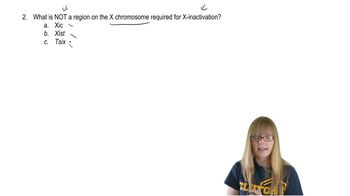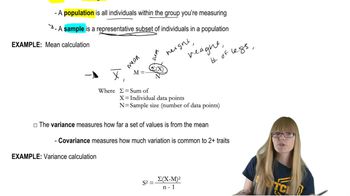Table of contents
- 1. Introduction to Genetics51m
- 2. Mendel's Laws of Inheritance3h 37m
- 3. Extensions to Mendelian Inheritance2h 41m
- 4. Genetic Mapping and Linkage2h 28m
- 5. Genetics of Bacteria and Viruses1h 21m
- 6. Chromosomal Variation1h 48m
- 7. DNA and Chromosome Structure56m
- 8. DNA Replication1h 10m
- 9. Mitosis and Meiosis1h 34m
- 10. Transcription1h 0m
- 11. Translation58m
- 12. Gene Regulation in Prokaryotes1h 19m
- 13. Gene Regulation in Eukaryotes44m
- 14. Genetic Control of Development44m
- 15. Genomes and Genomics1h 50m
- 16. Transposable Elements47m
- 17. Mutation, Repair, and Recombination1h 6m
- 18. Molecular Genetic Tools19m
- 19. Cancer Genetics29m
- 20. Quantitative Genetics1h 26m
- 21. Population Genetics50m
- 22. Evolutionary Genetics29m
10. Transcription
Transcription in Eukaryotes
Problem 15d
Textbook Question
Many promoter regions contain CAAT boxes containing consensus sequences CAAT or CCAAT approximately 70 to 80 bases upstream from the transcription start site. How might one determine the influence of CAAT boxes on the transcription rate of a given gene?
 Verified step by step guidance
Verified step by step guidance1
Identify the gene of interest and locate the CAAT box within its promoter region, approximately 70 to 80 bases upstream from the transcription start site.
Design a series of experiments using site-directed mutagenesis to create mutations in the CAAT box sequence. This could involve changing the CAAT or CCAAT sequence to a different sequence to observe the effects on transcription.
Use a reporter assay to measure the transcription rate. This involves cloning the promoter region with the mutated CAAT box upstream of a reporter gene, such as luciferase or GFP, and measuring the reporter gene's expression level.
Compare the transcription rates of the wild-type promoter with the mutated promoter. A decrease in transcription rate in the mutated promoter would suggest that the CAAT box is important for transcriptional activation.
Perform additional controls and replicates to ensure that the observed effects are specific to the CAAT box mutation and not due to other variables. This might include using a promoter with a known inactive CAAT box as a negative control.
 Verified video answer for a similar problem:
Verified video answer for a similar problem:This video solution was recommended by our tutors as helpful for the problem above
Video duration:
2mPlay a video:
Was this helpful?
Key Concepts
Here are the essential concepts you must grasp in order to answer the question correctly.
Promoter Regions
Promoter regions are specific DNA sequences located upstream of a gene that serve as binding sites for RNA polymerase and transcription factors. They play a crucial role in initiating transcription, as they determine when and how much of a gene is expressed. The presence of specific elements, such as CAAT boxes, can enhance or regulate the transcription process.
Recommended video:
Guided course

Regions of X Chromosomes
CAAT Boxes
CAAT boxes are conserved DNA sequences found in the promoter regions of many eukaryotic genes, typically located 70 to 80 bases upstream of the transcription start site. These sequences are recognized by transcription factors that can enhance the binding of RNA polymerase, thereby increasing the transcription rate of the associated gene. Their presence is often correlated with higher levels of gene expression.
Recommended video:
Guided course

Prokaryotic Transcription
Transcription Rate Measurement
The transcription rate of a gene can be measured using various techniques, such as quantitative PCR, RNA sequencing, or reporter gene assays. These methods allow researchers to quantify the amount of mRNA produced from a gene, providing insights into how regulatory elements like CAAT boxes influence gene expression. By comparing transcription levels in the presence and absence of these elements, one can assess their impact on transcription efficiency.
Recommended video:
Guided course

Mathematical Measurements

 9:16m
9:16mWatch next
Master Eukaryotic Transcription with a bite sized video explanation from Kylia Goodner
Start learningRelated Videos
Related Practice


